Perennial Herbs in the Kitchen Garden
Perennial herbs are real workhorses in the kitchen garden. Usually requiring little more than planting and harvesting. A little attention occasionally makes them work even harder for you. Some perennial herbs are evergreen and will supply fresh herbs all year round. Others are herbaceous perennials, in other words, they die down over winter to return in spring with renewed vigor.
Grow herbs in flower beds, vegetable beds or in a specially created area – a herb bed. Most herbs prefer free draining soil, in other words they don’t like to sit in waterlogged ground. They can also be used for as a living mulch or groundcover by choosing low growing herbs.
Plant herbs close to the kitchen to save time and energy when harvesting them. Many herbs grow well in pots, making them ideal for container gardens, growing on a patio or balcony. At Byther Farm we constructed a deep raised herb bed from recycled pallets. Sited near to the kitchen, therefore it is easy to access whenever I want fresh herbs for cooking.
A basic bouquet garni comprises parsley (often just the stalks that have masses of flavour), bay and thyme. I like to add a celery flavour into the mix, so use a little lovage or some celery leaves.
(Disclosure. Some of these are affiliate links. In other words, if you make a purchase we may earn a small commission. View our full disclosure statement)
Evergreen Perennial Herbs
Bay

Sweet bay, Laurus nobilis, is an evergreen Mediterranean shrub with mid to deep green leaves and small purple berries that follow white flowers. Left to grow they can reach 7.5m (23 feet) tall and almost as wide. But they can easily be clipped to fit the space you have. Bay is ideal for growing in large pots on a patio or can clipped into formal shapes.
Oregano
Oregano is an evergreen low growing herb with aromatic leaves and a strong taste. Certainly, it is often used in Mediterranean dishes. Grow in the kitchen garden, this perennial herb thrives in a warm, sunny position and dislikes being too wet in winter. Origanum vulgare has dark-green leaves and produces pink flowers. Harvest leaves before the flowers open. Variety Aureum Crispum has golden crinkly leaves and Greek oregano Origanum vulgare subsp. hirtum ‘Greek’ is good for drying, it has bright green leaves and produces white flowers.
Lavender
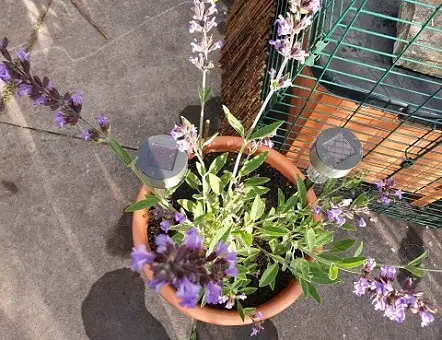
Lavender can be used lightly in cooking and has multiple uses in cleaning and cleansing products. Loved by bees and other pollinators, lavender flowers can be found in shades from white to dark purple. Depending on variety, bushes vary in size from compact 30cm high to 90cm or more. Lavender is easy to care for. They respond well to trimming, but do not cut back into woody material as they are unlikely to rejuvenate from it. A light trim of the growing tips encourages bushiness and more flowers.
(Image courtesy of Rebecca Rosslee)
Rosemary
Rosemary is a fragrant evergreen herb, native to the Mediterranean it grows well in most areas of UK. Traditionally used to flavor lamb dishes and to add warmth to soups and casseroles.
Thyme

Common thyme, Thymus vulgaris, has dark evergreen leaves and produces small pale purple flowers. There are many varieties of thyme available and all prefer well-drained soil. However, not all thymes have dark green leaves. A golden leaf variety is Archers Gold, which produces pink flowers. Green and yellow variegated leaf varieties are available, like Aureus AGM, which has a citrus taste. The aromatic leaves are ideal for culinary uses.
Sage
Sage is available in a variety of colors from silvery grey leaves, to purple or bi-color. It has a strong taste and used in savory dishes.
(image courtesy of Liz Peattie)
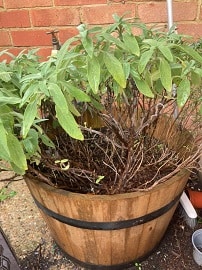
Winter Savoury
A semi-evergreen herb that adds warmth to dishes. Once established, winter savory needs little attention and grows as a low-growing, woody plant.
Herbaceous Perennial Herbs in the Kitchen Garden
Parsley
This common perennial herb is usually grown as an annual, although parsley survives the winter in milder areas. There are curled leaf and flat leaf varieties. Curled leaf parsley makes an attractive garnish on the plate. However, flat leaf parsley has a stronger taste and making it more useful in the kitchen. Hamburg parsley is a root vegetable and the leaves cut as fresh herb.
Lovage
A tall stately plant. The flowers form in umbels, held high above the foliage. Use lovage leaves as a base for stock and for adding warmth to the flavor of soups and stews. It dies down each winter and sends up new shoots from the basal rosette each spring.
Bronze fennel
The distinctive fine feathery leaves of fennel are used to flavor dishes and sauces. It also makes a good addition to a mixed leaf salad. Bronze fennel has a aniseed flavor and aroma.
Bermagot
Bergamot gives the floral fragrance to Earl Grey tea and can be used to make an infusion. Dry leaves for use in pot pourri. Grow this perennial herb in the kitchen garden or in ornamental flower beds where the flowers attract pollinators.
(Image courtesy of Ansie Hefer Vincente)
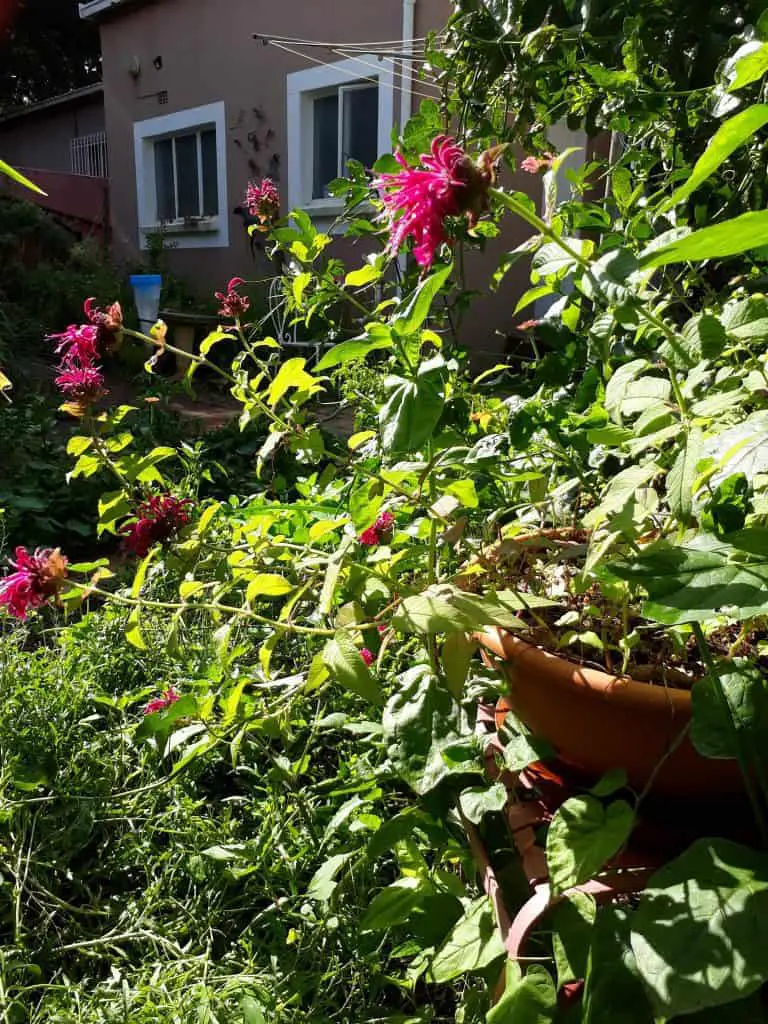
Lemon verbena
A tender perennial plant that is best grown in a pot that can be moved to a frost free place during winter. It grows to about 1 metre (3 feet) high and produces purple flower buds that open to white flowers. It has an intense lemon scent and therefore, is ideal for use in pot pourri, adding to flower arrangements and in making herbal tea infusions.
Lemon balm

Part of the mint family of plants, it grows readily from seed and can form large clumps in just a few years. Lemon balm makes a delicious hot infusion as alternative to tea or coffee.
Sweet marjoram
Similar to oregano, however marjoram is most often used fresh, rather than dried. Harvest the leaves before the flowers open. It has a delicate flavour used in Mediterranean dishes.
Roman chamomile
Grown as a medicinal herb. It has a distinctive aroma and small daisy-like flowers. Dry the flowers head to make chamomile tea. This article gives a detailed account of the uses of Roman chamomile.
Salad burnet
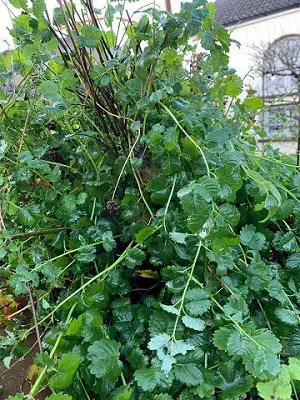
Salad burnet is one of the trouble free perennial herbs for the kitchen garden with a mild taste, however it can also be used as a vegetable in the kitchen garden.
Sorrel
Sorrel has an intense lemon taste for use in salads and cooked dishes. This perennial herb has several forms included a red-veined sorrel. It grows easily from seed and will produce self-sown, volunteer plants readily. Try adding it to a sauce to accompany fish to add a lemony tang when there are no fresh lemons available.
French tarragon

French tarragon adds a distinctive aniseed flavor to cooking. Milder and finer in flavor than Russian tarragon, it is also more tender and prone to frost damage.
Chives
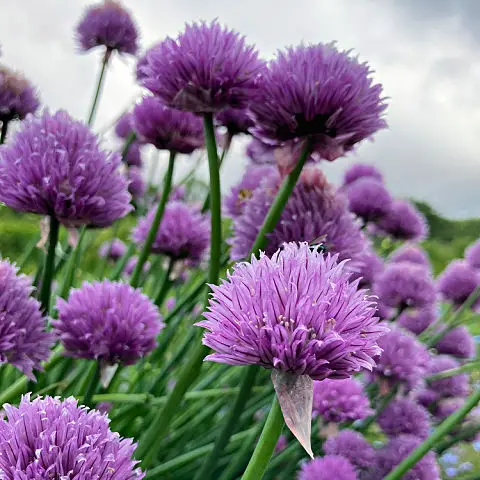
The leaves of chives are suitable for use in cooked and cold meals. Chopped leaves make an ideal garnish to many savory meals. The purple flowers are also edible. Use the flowers to make chive vinegar, for use in dressings.
Garlic chives
Similar to chives, but with a mild garlic taste.
Image credits
All the images in this article, Perennial Herbs in the kitchen garden, were kindly provided by members of the Facebook group Friends of Liz Zorab – Byther Farm.
Featured image of herb bed courtesy of Annette Hurt.
- Baby pepper inside pepper | Strange vegetable - September 16, 2025
- Biennials to sow in June and July - September 12, 2025
- Protected: Urban back garden - August 28, 2025

Nice list of herbs. I love the Bergamot and imagine it attracts hummingbirds with its red blossoms. Planted near a window, you could watch them.👌
There are a few herbs there that I’ve never tasted. I will have to look out for them at my local plant nursery.